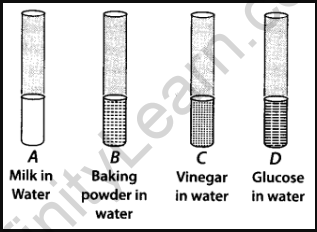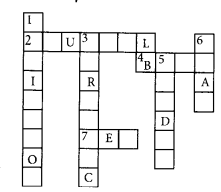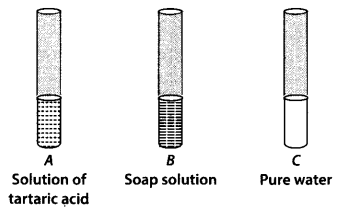Table of Contents
NCERT Exemplar Solutions Class 7 Science Chapter 5 Pdf
NCERT Exemplar class 7 solutions for Acids, Bases, and Salts have been created to provide students with a comprehensive understanding of the subjects covered in the NCERT textbooks. By regularly utilizing these solutions, students can effectively practice and enhance their preparation, thereby increasing their chances of achieving excellent results in their annual examinations.
These NCERT Exemplar Class 7 Science Solutions encompass a variety of question types, including multiple-choice questions, queries involving the identification of indicators, real-life examples, concise response questions, and descriptive answer questions. This diversified approach to questioning ensures that students are exposed to a wide range of topics, thereby facilitating a more thorough grasp of the subject matter.
Access Answers of NCERT Exemplar for Class 7 Science Chapter 5 – Acids, Bases and Salts
Multiple Choice Questions
Question 1. The correct way of making a solution of acid in water is to
(a) add water to acid
(b) add acid to water
(c) mix acid and water simultaneously
(d) add water to acid in a shallow container.
Ans: (b) The correct way of making a solution of acid in water is to add acid to water. It is an exothermic reaction and a large amount of heat is produced if water is added to acid.
Question 2. Products of a neutralisation reaction are always
(a) an acid and a base
(b) an acid and a salt
(c) a salt and water
(d) a salt and a base.
Ans. (c) Salt and water are produced as a result of neutralisation reaction, e.g., NaOH + HCl → NaCl + H2O
Question 3. Turmeric is a natural indicator. On adding its paste to acid and base separately, which colours would be observed?
(a) Yellow in both acid and base
(b) Yellow in acid and red in base
(c) Pink in acid and yellow in base
(d) Red in acid and blue in base
Ans. (b) Turmeric paste is yellow in colour. So it remains yellow in acid and changes its colour to red in base.
Question 4. Phenolphthalein is a synthetic indicator and its colours in acidic and basic solutions, respectively are
(a) red and blue
(b) blue and red
(c) pink and colourless
(d) colourless and pink.
Ans. (d) Phenolphthalein remains colourless in acidic solution and turns pink in basic solution.
Question 5. When the soil is too basic, plants do not grow well in it. To improve its quality what must be added to the soil?
(a) Organic matter
(b) Quicklime
(c) Slaked lime
(d) Calamine solution
Ans. (a) Organic matter is to be added to a basic soil to neutralise the base and improve its quality.
Question 6. ‘Litmus’, a natural dye is an extract of which of the following?
(a) China rose (Gudhal)
(b) Beetroot
(c) Lichen
(d) Blue berries (Jamuri)
Ans. (c) Litmus, a natural dye used as an indicator is extracted from lichen.
Question 7. Neutralisation reaction is a
(a) physical and reversible change
(b) physical change that cannot be reversed
(c) chemical and reversible change
(d) chemical change that cannot be reversed.
Ans. (d) Neutralisation is a chemical and irreversible change. The salt and water formed are new products and cannot be converted back to acid and base.
Question 8. A solution changes the colour of turmeric indicator from yellow to red. The solution is
(a) basic
(b) acidic
(c) neutral
(d) either neutral or acidic.
Ans. (a) Basic solutions change the colour of turmeric indicator from yellow to red.
Question 9. Which of the following set of substances contain acids?
(a) Grapes, lime water
(b) Vinegar, soap
(c) Curd, milk of magnesia
(d) Curd, vinegar
Ans. (d) Curd and vinegar contain lactic acid and acetic acid respectively.
Question 10. On adding phenolphthalein indicator to colourless solution, no change is observed. What is the nature of this solution?
(a) Basic
(b) Either acidic or basic
(c) Either acidic or neutral
(d) Either basic or neutral
Ans. (c) Colour of the phenolphthalein does not change with acidic or neutral solution.
Question 11. Which of the following is an acid-base indicator?
(a) Vinegar
(b) Lime water
(c) Turmeric
(d) Baking soda
Ans. (c) Turmeric is an acid-base indicator. It is yellow in acidic solution and red in basic solution.
Students can also access the NCERT Solutions for Class 7 for their preparation-
- NCERT Solutions for Class 7 Maths
- NCERT Solutions for Class 7 Science
- NCERT Solutions for Class 7 Social Science
- NCERT Solutions for Class 7 English
Very Short Answer Type Questions
Question 12. Look at the given reaction.
Hydrochloric acid + Sodium hydroxide (base) → Sodium chloride (salt) + Water Sodium chloride formed in this reaction remains in solution form. Can we get solid sodium chloride from this solution? Suggest a method (if any).
Ans. Sodium chloride is soluble in water hence a solution of sodium chloride in water is formed. Sodium chloride can be separated from this solution by evaporation.
Question 13. State whether the following statements are true or false. Correct the false statements.
(a) All substances are either acidic or basic.
(b) A compound if acidic will turn all indicators red.
(c) Lime water turns red limus blue.
(d) Common salt dissolved in water turns blue litmus red.
(e) Phenolphthalein is a natural indicator.
(f) Calamine can be used to treat ant’s sting.
(g) Lemon water is basic in nature.
Ans.
(a) False – Substances can be acidic, basic or neutral
(b) False – Acids do not give red colour with all indicators.
(c) True – Lime water is basic in nature.
(d) False – Blue litmus does not change to red in common salt solutions since it is neutral.
(e) False – Phenolphthalein is a synthetic indicator.
(f) True – Ant’s sting contains formic acid hence can be neutralised by calamine solution, which contains zinc carbonate.
(g) False – Lemon water is acidic in nature.
Question 14. Paheli is suffering from indigestion due to acidity. Is it advisable to give her orange juice in this situation and why?
Ans. No, orange juice is acidic in nature. She requires antacids which are basic in nature and neutralise excess acid in the stomach.
Short Answer Type Questions
Question 15. Look at figure which shows solutions taken in test tubes A, B, C and D. What colour is expected when a piece of red litmus paper is dropped in each test tube? Nature of the solutions is given in the table for your help

| Test tube | Nature of Solution | Change in colour of red litmus |
| A | Neutral | |
| B | Basic | |
| C | Acidic | |
| D | Neutral |
Ans.
| Test tube- solution in water | Nature of solution | Change in colour of red litmus |
| A (Milk) | Neutral | No change |
| B (Baking powder) | Basic | Turns blue |
| C (Vinegar) | Acidic | No change |
| D (Glucose) | Neutral | No change |
Question 16. While playing in a park, a child was stung by a wasp. Some elders suggested applying paste of baking soda and others lemon juice as remedy. Which remedy do you think is appropriate and why?
Ans. Wasp sting injects a liquid in the skin which is acidic in nature. Hence baking soda is applied as it is basic in nature and neutralises the acid.
Question 17. Form a sentence using the following words-baking soda, ant bite, moist, effect, neutralised, rubbing.
Ans. The effect of an ant bite can be neutralised by rubbing moist baking soda.
Question 18. Match the substances in Column I with those in Column II.
| Column 1 | Column II | ||
| (a) | Tartaric acid | (i) | soap |
| (b) | Calcium hydroxide | (ii) | curd |
| (c) | Formic acid | (iii) | unripe mangoes |
| (d) | Sodium hydroxide | (iv) | ant’s sting |
| (e) | Lactic acid | (v) | lime water |
Ans.
(a) (iii)
(b) (v)
(c) (iv)
(d) (i)
(e) (ii)
Question 19. Fill in the blanks in the following sentences.
(a) Lemon juice and vinegar taste _____ because they contain _____.
(b) Turmeric and litmus are _____ acid-base indicators.
(c) Phenolphthalein gives _____ colour with lime water.
(d) When an acidic solution is mixed with a basic solution, they _____ each other forming _____ and water.
Ans.
(a) sour, acids
(b) natural
(c) pink
(d) neutralise, salt
Long Answer Type Questions
Question 20. Boojho, Paheli and their friend Golu were provided with a test tube each containing China rose solution which was pink in colour. Boojho added two drops of solution ‘A’ in his test tube and got dark pink colour. Paheli added 2 drops of solution ‘B’ to her test tube and got green colour. Golu added 2 drops of solution ‘C but could not get any change in colour. Suggest the possible cause for the variation in their results.
Ans. ‘A’ is acidic solution, China rose solution turns dark pink in acids. ‘B’ is a basic solution since China rose solution turns green in basic solution. ‘C’ is a neutral solution hence there is no change in colour of China rose solution.
Question 21. Fill in the crossword given as figure with the help of the clues provided.

(2) The solution which does not change the colour of either red or blue litmus.
(4) Phenolphthalein gives pink colour in this type of solution.
(7) Colour of blue litmus in lemon juice. Down
(1) It is used to test whether a substance is acidic or basic.
(3) It is a natural indicator and gives pink colour in basic solution.
(5) Nature of ant’s sting.
(6) It is responsible for increase in temperature during a neutralisation reaction.
Ans.

Across
2. Neutral
4. Base
7. Red
Down
1. Indicator
3.Turmeric
5. Acidic
6. Heat
Question 22. A farmer was unhappy because of his low crop yield. He discussed the problem with an agricultural scientist and realised that the soil of his field was either too acidic or too basic. What remedy would you suggest the farmer to neutralise the soil?
Ans. If the soil is too acidic it should be treated with bases such as quick lime (calcium oxide) or slaked lime (calcium hydroxide). If the soil is too basic, organic matter is added to it. Organic matter releases acids which neutralise the basic nature of the soil.
Question 23. You are provided with four test tubes containing sugar solution, baking soda solution, tamarind solution, salt solution. Write down an activity to find the nature (acidic/basic/ neutral) of each solution.
Ans. Add blue litmus solution and then red litmus solution and note down the change in colour. Sugar solution – No change in colour of blue or red litmus solution. Baking soda solution – Turns red litmus blue. Tamarind solution – Turns blue litmus red. Salt solution – No change in colour of blue or red litmus solution. Hence, Sugar solution, salt solution – neutral Baking soda solution– basic Tamarind solution – acidic
Question 24. You are provided with three test tubes A, B and C as shown in figure with different liquids. What will you observe when you put
(a) a piece of blue litmus paper in each test tube
(b) a piece of red litmus paper in each test tube
(c) a few drops of phenolphthalein solution to each test tube?

Ans.
| Test tube | Effect on blue litmus paper | Effect on red litmus paper | Effect on phenol – phthalein solution |
| A | turns red | no change | colourless |
| B | no change | turns blue | turns pink |
| C | no change | no change | colourless |
Question 25. Paheli observed that most of the fish in the pond of her village were gradually dying. She also observed that the waste of a factory in their village is flowing into the pond which probably caused the fish to die.
(a) Explain why the fish were dying.
(b) If the factory waste is acidic in nature, how can it be neutralised?
Ans.
(a) Since the factory waste is being disposed off in the river, it can kill the fish because factory waste may contain acids or bases or other toxic materials.
(b) If the factory waste is acidic in nature it can be neutralised by adding basic substances like lime before disposing off in the river.
Question 26. Explain two neutralisation reactions related to daily life situation.
Ans.
(a) Indigestion: Due to indigestion a large amount of acid is released in the stomach which causes acidity. This acid is neutralised by taking antacids like milk of magnesia.
(b) Ant’s sting: Ant’s sting releases formic acid in the skin. It can be neutralised by rubbing baking soda or putting calamine lotion.
FAQs on NCERT Exemplar Solutions Class 7 Science Chapter 5
From which source the litmus solution is obtained in these NCERT Exemplar Solutions?
Litmus solution is obtained from Lichens. It is generally used as an indicator to determine the basic and acidic nature of the solution. Students who are unable to understand this topic can refer to the NCERT Exemplar Solutions from Infinity Learn. The solutions are designed by subject matter experts having rich in experience in their subject to help students score well in the exam. Both chapter-wise and exercise-wise formats of solutions can be utilized by the students to get their queries cleared instantly.
What are the benefits of using NCERT Exemplar Solutions?
NCERT Exemplar Solutions by Infinity Learn is designed strictly according to the latest CBSE syllabus and it is the best way to study this chapter containing all the important points and formulas. The subject matter experts designed these NCERT Exemplar Solutions with an aim to make the learning process the most convenient way.
What concepts can I learn from these NCERT Exemplar Solutions?
The concepts like: Acids And Bases, Natural Indicators Around Us, Neutralisation, Neutralisations In Everyday Life.







